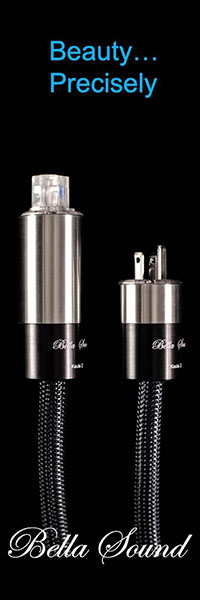Tweakaholics Anonymous
| Tweakaholics Anonymous |
| Commentary |
| Marshall Nack |
| April 1999 |
Note: Here’s one man’s approach to creating his listening room from scratch. Hope it stimulates your thinking.
Disclaimer: the following opinions are my subjective observations. I did not corroborate the conclusions with an accredited acoustician.
After being in my new room for 6 months, it’s finally approaching optimal setup. The major setup issues have been addressed. Minor ones never end.
I planned the new layout thoroughly. First, a proportional floor plan was made up, along with cutouts of the furniture and componentry. Many hours passed moving the cutouts around the board. This was not altogether unproductive and it’s a hell of a lot easier on your back. I came up with a few promising options, based on what I had read in mags.
Placing things by the rule of thirds looked great on paper. The sonic outcome came out differently in 3D.
Here are some observations I’ve come upon by trial and error.
-
You’ve probably read that it’s a good idea to put plants in the listening room. I went out and bought a large Ficus, among others. I can tell you now – don’t put them in the center area or behind the speakers. Along side walls or in the corners is probably OK. But their diffusive properties merely served to make my stage less precise. I think you want the real estate behind and between the speakers to be empty. And acoustical treatments work better than plants in the corners.
-
Putting your component rack between the speakers is not a good idea. This goes along with point 1) above. The harmful effects of a center rack are made worse the further out into the room you put it. When I had my 5 tier Solid Steel rack level with the speaker plane the stage was blurry. As I inched it back towards the front wall imaging kept improving. Right up against the front wall is the best if you must use center placement.
-
I have a nice looking wood buffet behind the hot seat on the couch. Being an upright bourgeoisie I naturally have fine art on it. It looks quite nice. Who would have thought these small objects directly behind the listeners head would interfere with imaging? I’m telling you this caused the oddest of aberrations, one that I nicknamed ‘The Wandering Soloist’. At certain high frequencies, the image would shift to the left. A violin in it’s midrange would appear solidly in the center, but as it went up the scale, would move left of center! This was really magical when double stops were played. The soloist could occupy 1/2 the stage.
Another example occurred on the excellent recording This Worlde’s Joie, (EMI ASD 3301), by William Mathias, a contemporary Welsh composer. When the baritone Michael Rippon comes in his voice seems to have 2 discernable components. It doesn’t fuse to an integrated simulacrum. The simple removal of the objects from the buffet made the voice whole. How come? Why does this happen? Interesting questions with no obvious answers. I’ve learned to be satisfied just getting the problem fixed. Bottom line: keep things from near proximity to the back of your head.
In my old room I didn’t have these problems. The sound quality was very good, given the limitations. Because it measured 12′ X 12′, there weren’t many options. The speakers were 5′ out from the front wall and nearly touching the side walls. The listener was up against the rear wall. Most wall surfaces had fabric or other diffusive treatment. Stage width, depth, and specificity were uncanny; the palpability was such that people assumed there must be tubes somewhere in the chain, when there weren’t. Admittedly the BAT VK200 lent some warmth, but not that doesn’t account for the palpability. Chamber music was served especially well. But ever present was a certain leanness, a lack of orchestral weight. It was this deficit that made me jump at the opportunity to remove an interior wall and expand the listening room.
On to other subjects. There’s a lot of buzz now about loosening the covers on locking style RCA plugs. For some reason this does have a big impact. Be careful. What changed noticeably was instrumental timbre, which became more lean, with less mid and lower overtones. Along with this image size shrunk, placement became more precise. There seemed to be more info. The removal of the overtones lets you ‘see’ more clearly what’s left. But this stuff was always there to begin with. You’re actually getting less info. This tweak may work for some who have an overly ripe presentation. You can adjust the degree of tightness of the RCA for varied impact.
Endnote: My new room measures 12′ X 31′. I’m using heavily modified Magnepan MG3.3 speakers, a BAT VK200 stereo amp, McCormack TLC1 passive line stage, Dan Fanny’s Non-Signature phono stage, and a Linn LP12 with an Audioquest 7000 cartridge. All wires are by Harmonic Technology, except the phono cable. A lot of BYBEE filters are used throughout. Oh, and last but not least, I’m a 100% analog vinyl dinosaur.
![]()
Don’t forget to bookmark us! (CTRL-D)
Stereo Times Masthead
Publisher/Founder
Clement Perry
Editor
Dave Thomas
Senior Editors
Frank Alles, Mike Girardi, Russell Lichter, Terry London, Moreno Mitchell, Paul Szabady, Bill Wells, Mike Wright, and Stephen Yan,
Current Contributors
David Abramson, Tim Barrall, Dave Allison, Ron Cook, Lewis Dardick, John Hoffman, Dan Secula, Don Shaulis, Greg Simmons, Eric Teh, Greg Voth, Richard Willie, Ed Van Winkle, Rob Dockery, Richard Doron, and Daveed Turek
Site Management Clement Perry
Ad Designer: Martin Perry





Be the first to comment on: Tweakaholics Anonymous